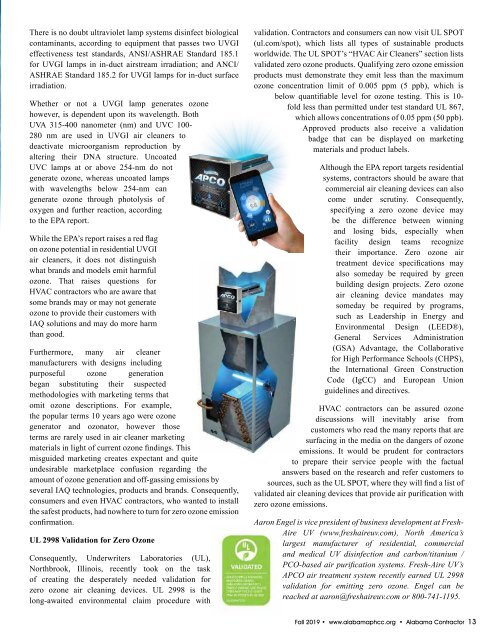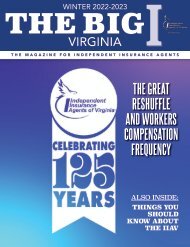Alabama Contractor Fall 2019
You also want an ePaper? Increase the reach of your titles
YUMPU automatically turns print PDFs into web optimized ePapers that Google loves.
There is no doubt ultraviolet lamp systems disinfect biological<br />
contaminants, according to equipment that passes two UVGI<br />
effectiveness test standards, ANSI/ASHRAE Standard 185.1<br />
for UVGI lamps in in-duct airstream irradiation; and ANCI/<br />
ASHRAE Standard 185.2 for UVGI lamps for in-duct surface<br />
irradiation.<br />
Whether or not a UVGI lamp generates ozone<br />
however, is dependent upon its wavelength. Both<br />
UVA 315-400 nanometer (nm) and UVC 100-<br />
280 nm are used in UVGI air cleaners to<br />
deactivate microorganism reproduction by<br />
altering their DNA structure. Uncoated<br />
UVC lamps at or above 254-nm do not<br />
generate ozone, whereas uncoated lamps<br />
with wavelengths below 254-nm can<br />
generate ozone through photolysis of<br />
oxygen and further reaction, according<br />
to the EPA report.<br />
While the EPA’s report raises a red flag<br />
on ozone potential in residential UVGI<br />
air cleaners, it does not distinguish<br />
what brands and models emit harmful<br />
ozone. That raises questions for<br />
HVAC contractors who are aware that<br />
some brands may or may not generate<br />
ozone to provide their customers with<br />
IAQ solutions and may do more harm<br />
than good.<br />
Furthermore, many air cleaner<br />
manufacturers with designs including<br />
purposeful ozone generation<br />
began substituting their suspected<br />
methodologies with marketing terms that<br />
omit ozone descriptions. For example,<br />
the popular terms 10 years ago were ozone<br />
generator and ozonator, however those<br />
terms are rarely used in air cleaner marketing<br />
materials in light of current ozone findings. This<br />
misguided marketing creates expectant and quite<br />
undesirable marketplace confusion regarding the<br />
amount of ozone generation and off-gassing emissions by<br />
several IAQ technologies, products and brands. Consequently,<br />
consumers and even HVAC contractors, who wanted to install<br />
the safest products, had nowhere to turn for zero ozone emission<br />
confirmation.<br />
UL 2998 Validation for Zero Ozone<br />
Consequently, Underwriters Laboratories (UL),<br />
Northbrook, Illinois, recently took on the task<br />
of creating the desperately needed validation for<br />
zero ozone air cleaning devices. UL 2998 is the<br />
long-awaited environmental claim procedure with<br />
validation. <strong>Contractor</strong>s and consumers can now visit UL SPOT<br />
(ul.com/spot), which lists all types of sustainable products<br />
worldwide. The UL SPOT’s “HVAC Air Cleaners” section lists<br />
validated zero ozone products. Qualifying zero ozone emission<br />
products must demonstrate they emit less than the maximum<br />
ozone concentration limit of 0.005 ppm (5 ppb), which is<br />
below quantifiable level for ozone testing. This is 10-<br />
fold less than permitted under test standard UL 867,<br />
which allows concentrations of 0.05 ppm (50 ppb).<br />
Approved products also receive a validation<br />
badge that can be displayed on marketing<br />
materials and product labels.<br />
Although the EPA report targets residential<br />
systems, contractors should be aware that<br />
commercial air cleaning devices can also<br />
come under scrutiny. Consequently,<br />
specifying a zero ozone device may<br />
be the difference between winning<br />
and losing bids, especially when<br />
facility design teams recognize<br />
their importance. Zero ozone air<br />
treatment device specifications may<br />
also someday be required by green<br />
building design projects. Zero ozone<br />
air cleaning device mandates may<br />
someday be required by programs,<br />
such as Leadership in Energy and<br />
Environmental Design (LEED®),<br />
General Services Administration<br />
(GSA) Advantage, the Collaborative<br />
for High Performance Schools (CHPS),<br />
the International Green Construction<br />
Code (IgCC) and European Union<br />
guidelines and directives.<br />
HVAC contractors can be assured ozone<br />
discussions will inevitably arise from<br />
customers who read the many reports that are<br />
surfacing in the media on the dangers of ozone<br />
emissions. It would be prudent for contractors<br />
to prepare their service people with the factual<br />
answers based on the research and refer customers to<br />
sources, such as the UL SPOT, where they will find a list of<br />
validated air cleaning devices that provide air purification with<br />
zero ozone emissions.<br />
Aaron Engel is vice president of business development at Fresh-<br />
Aire UV (www.freshaireuv.com), North America’s<br />
largest manufacturer of residential, commercial<br />
and medical UV disinfection and carbon/titanium /<br />
PCO-based air purification systems. Fresh-Aire UV’s<br />
APCO air treatment system recently earned UL 2998<br />
validation for emitting zero ozone. Engel can be<br />
reached at aaron@freshaireuv.com or 800-741-1195.<br />
<strong>Fall</strong> <strong>2019</strong> • www.alabamaphcc.org • <strong>Alabama</strong> <strong>Contractor</strong> 13


















